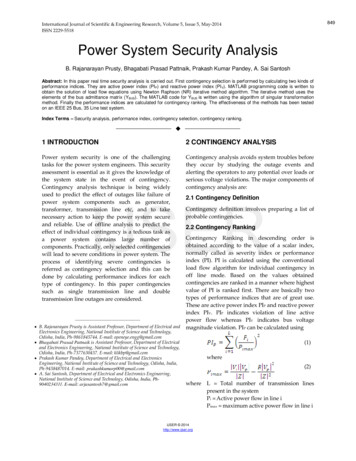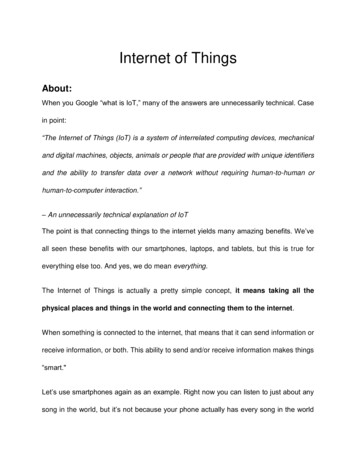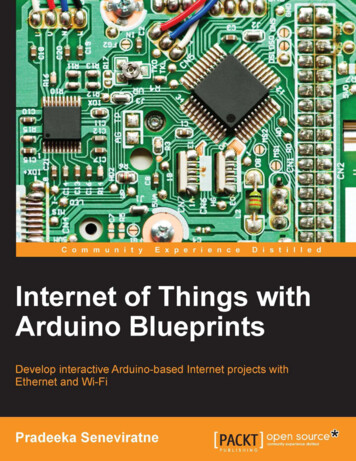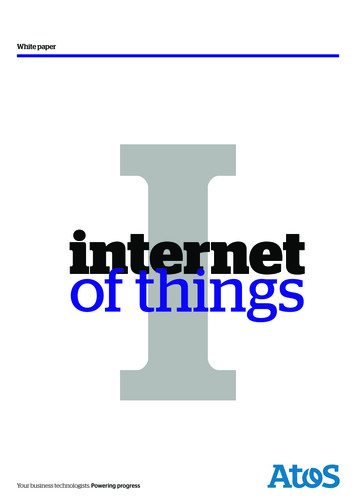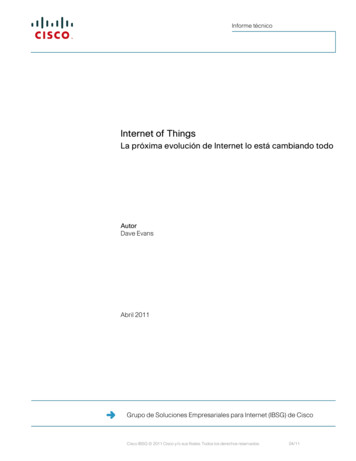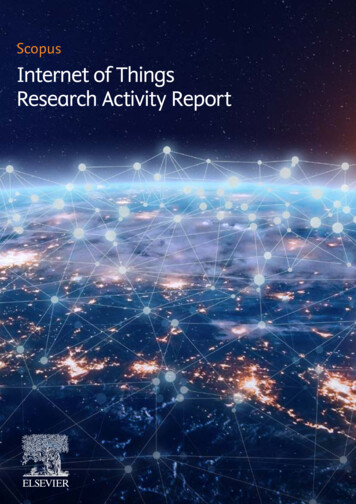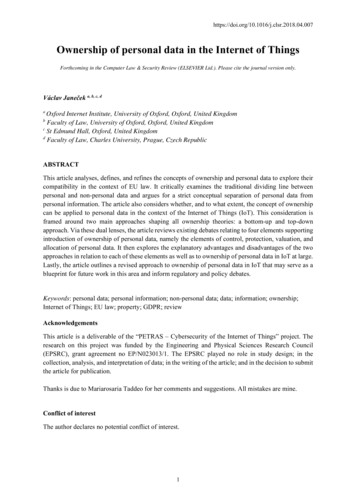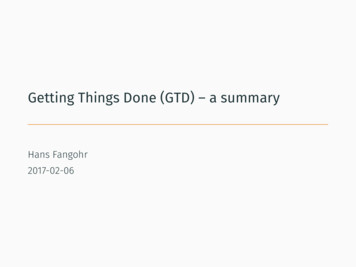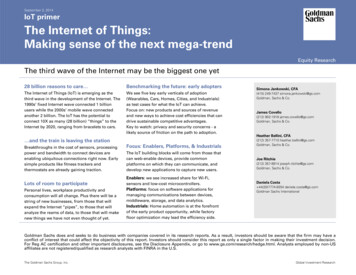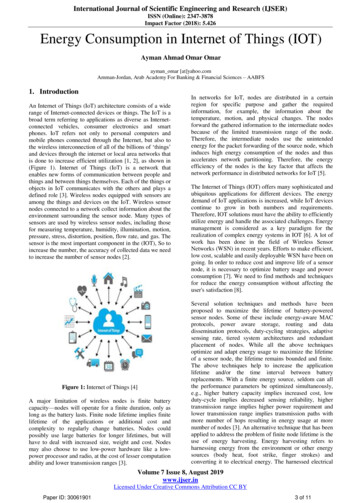
Transcription
International Journal of Scientific & Engineering Research, Volume 7, Issue 4, April-2016ISSN 2229-551820INTERNET OF THINGSSruthi.R, B.E(CSE)sruthireghu0422@gmail.comNehru Institute of Engineering and .comNehru Institute of Engineering and TechnologyAbstract-The paper is all about the upcomingtechnology “Internet of things”.As it is one of thelatest trend it deals with many real time and dayto-dayobjects.Internet of things exists because it isgoing to dominate all the other technologiesincluding cloud computing.There is no fields of lifewhere Internet of Things is notapplied.In thecoming years all the electronic, softwares,networks,machines and all the devices will beworking with Internet of Things.Later, between 1993 and 1996 several industriesproposedsolutions like Microsoft’s at Work or Novell’sNEST.Bill Joy envisioned Device to Device(D2D)communications as part of “Six Webs” framework,presented at the World Economic Fortum at Davos in1999.The concept of the Internet of Things became famous inthe year 1999, through the Auto-ID center at MIT andrelated marketing analysis publications.IJSERKeywords- IoT devices,Web of Things, Big Data.TABLE 1I.INTRODUCTIONThe network of physical objects such as devices,vehicles ,buildings and some other things includingembedded systems, software, and network connectivityare collectively called as “Internet of Things”.The Internetof Things becomes an instance of cyber systems, also forthe technologies such as smart grids,Intelligenttransportation and smart cities.Kevin Ashton, a British entrepreneur coined the name“Internet of Things” in the year 1999.As a change IoToffers the advanced connectivity that goes beyond themachine-to-machine(M2M) communications.II.EARLY HISTORYIn the early 1982, the concept of networked smartdevices was discussed. A coke machine at CarnegieMelton university became the first internet-connecteddevice.Mark Weiser’s seminar paper on “Ubiquitouscomputing” ,”The computer of 21st century”, also theacademic venuessuch as Ubicomp and Percompproduced the contemporary vision of Internet of Things.IEEE spectrum as moving small packets of data to alarge set of nodes, described by Reza Raji in 1994, so asto integrating and automating everything from homeappliances to entire .2III.APPLICATIONSThere will be nearly 26 billion devices on the Internet ofThings by 2020, according to Gartner,Inc. (a technologyresearch and advisory corporation).ABI researchestimates that more than 30 billion devices will beIJSER 2016http://www.ijser.org
International Journal of Scientific & Engineering Research, Volume 7, Issue 4, April-2016ISSN 2229-5518wirelessly connected to the Internet of Things by 2020.Asa technological innovation, the UK government allocated 40,000,00 towards research into Internet of Things, intheir 2015 budget.IP address will be used as a unique identifier inintegration with the internet. As the address space of IPv4is limited, the objects in the IoT uses IPv6 toaccomodate the extremely large address spaces. To agreater extentthe future of the IoT will not be possible without using theIPvA.MEDIAThe media and big data are interconnected, so it is mustto provide some context in the media processingmechanism.The ultimate aim is to serve, or convey, amessage or a content that is in line with the consumer’smindset.The media industries process the Big Data in a dual andinterconnected manner: Tragetting of consumersData-capture21D.MANUFACTURINGDigital control systems to automate the process and sec,operator tools and services information systems tooptimize plant safety and security are within the purviewof the IoT.E.ENERGY MANAGEMENTIt is expected that IoT devices will be integrated into allforms of energy consuming devices (switches, poweroutlets, bulbs, television etc.,). Such devices would alsooffer the opportunity for users to remotely control theirdevices, or centrally manage them via cloud basedinfrastructure.Using Advanced Metering Infrastructure (AMI)Devices connected to the internet backbone,electricutilities can not only collect data from end-userconnections but also manage other distributionautomation devices like transformers and reclosersIJSERF.MEDICAL AND HEALTHCARE SYSTEMSThe IoT serves an opportunity to measure, collectAnd analyse an ever-increasing variety of behaviouralstatistics. Cross-correlation of this data couldrevolutionise the targeted marketing of of products andservices.Big Data and the IoT works in a conjuctional manner.device interconnectivity. The Internet of Thingstransforms the media industry, companies andgovernments, there by opening up a new era of economicgrowth and competitiveness.IoT devices can be used to enable remote healthmonitoring and emergency notification systems .Thesehealth monitoring systems can range from blood pressureand heart rate monitors to advanced devices capable ofmonitoring specialized implants, such as pace makers oradvanced aids.G. LARGE SCALE DEPLOYMENTSThe applications of IoT in the field of Environmentalmonitoring uses sensors to assist in environmentalprotection by monitoring the air or water quality,atmospheric or soil conditions, and also the movements ofwildlife and their habitats.Devices connected to theinternet can be used to earthquake and tsunami-earlywarning systems.There are several ongoing or planned large-scaledeployments of the IoT. For Example Songdo,SouthKorea, the first of its kind fully equipped and wired city.This is implemented only with the help of IoT.Another example of large deployment is the completedNew York Water Ways(NYWW) in the New York city toconnect all their vessels and being able to monitor themlively 24/7. The network is deigned and engineered byFluidsmesh Networks. New applications can includesecurity, energy and fleet management, digital signage,public wi-fi, paperless ticketing and others.C.INFRASTRUCTURE MANAGEMENTH. TRANSPORTATIONB.ENVIRONMENTAL MONITORINGMonitoring and controlling the urban and ruralinfrastructure like bridges, railway tracks on and off-shorewind farms is a key application of IoT. The IoT devicescan be used to control critical infrastructure like bridgesto provide access to ships. Even the areas such as wastemanagement can benefit from automation andoptimization that could be brought by the IoT.IJSER 2016http://www.ijser.orgFig.1: digital speed limit signSpeedLimit50
International Journal of Scientific & Engineering Research, Volume 7, Issue 4, April-2016ISSN 2229-5518The IoT can assist in integration of communications,control, and information processing across variousTransportation systems i.e. the vehicle, infrastructure, andthe driver and user etc.,IV. UNIQUE ADDRESSABILITY OFTHINGSThe orginal idea of the Auto-ID Center is based onRFID-tags and unique identification through theElectronic Product Code however, this has evolved toobjects having an IP address or URI.From the world of Semantic Web, as an alternativeview, it focuses on making all things(not just theelectronics, smart or RFID-enabled) addressable by theexisting naming protocols, such as URI. The objectsthemselves do not converse ,but they may now be referredby the other agents, such as powerful centralized serversacting for their human owners.The next generation of Internet applications usingcommunicate with devices attached to virtually allhuman-made objects because of the large addressingspace of IPv6.The combination of these ideas can be found in thecurrent GS1/EPCglobal information services (EPCIS)specifications.22But, there is a shift in research to integrate the concepts ofInternet of Things and Autonomous control, with initialoutcomes towards this direction considering objects as thedriving force of autonomous IoT.In the upcoming days the Internet of Things may be anon-deterministic and open network in which autoorganized or Intelligent entities(Web Services, perable and able to act independently depending onthe context, circumstances and environments.VI.ARCHITECTUREThe system follows an Event-driven Architecture.It isBottom-Up made and will consider any subsidiary level.Thus , model driven and functional approaches willcoexist with new ones able to treat exceptions andunusual evolution of processes (Multi-agent systems, BADS etc.,).In the Internet of Things, the event does not meansbased on a deterministic or syntactic model. Instead, eventwill be based on the context of the event itself, this canalso be a Semantic Web.Building on the top of IoT, the Web of Thingsis anarchitecture for the application layer of the Internet ofThings, looking at the convergence of data from IoTdevices into Web applications to create innovative usecases.IJSERV.TRENDS AND CHARACTERISTICSVII.NETWORK ARCHITECTUREThe latest trends and characteristics can be explained bymeans of the following figure.The Internet of Things requires huge scalability in thenetwork space to handle the surge of devices.IETF6LoWPAN would be used to connect devices to IPnetworks with billions of devices. IPv6 will play an majorrole in handling the network scalability.Teleoperation andtelepresenceVIII.COMPLEX SYSTEMSPhysical worldwebUbiquitouspositioningIn semi-open or closed loop, it will be considered as aComplex system, because of the huge number of differentlinks and interactions between Autonomous actors, and itscapacity to integrate new actors. At the overall stage itwill be seen as Achaotic environment.Locating people andeverydayobjectsSecurity,healthcare,Vertical marketappstransport,documentmanagementIX. A BASKET OF REMOTESSupply chainRFIDhelperstags forrouting and lossSupply chain et of ThingsA.INTELLIGENCEThe Ambient Intelligence and Autonomous Control arenot a part of the original concept of Internetof Things.According to CEO if Cisco, the remote controlmarket is expected to be a USD 19 trillion market. ManyIoT devices have a potential to take a piece of this market.Then, there exists “ Basket of remotes” problem, wherewe will have hundreds of applications to interface withhundreds of devices that don’t share protocols forspeaking with one another.There are several ways to find solution for thisproblem. One of them is “ Predictive Interaction” whereIJSER 2016http://www.ijser.org
International Journal of Scientific & Engineering Research, Volume 7, Issue 4, April-2016ISSN 2229-5518cloud or fog based decision makers will predict the user’snext action and reaction.This problem is also a competitive advantage forsome very technical startup companies with fastcapabilities.early 2010s, with uses such as reading NFC tagsor for access to public transportation.2. Optical tags and quick response codes - This isused for low cost tagging. Phone camerasdecodes QR code using image-processingtechniques. In reality QR advertisementcampaigns gives less turnout as users need tohave another application to read QR codes.3. Bluetooth low energy - This is one of the latesttech. All newly releasing smart phoneshave BLE hardware in them. Tags based onBLE can signal their presence at a power budgetthat enables them to operate for up to one yearon a lithium coin cell battery.X. FRAMEWORKSInternet of Things frameworks helps supporting theinteraction between "things" and allow for more-complexstructures like Distributed system and the development ofDistributed applications. Nowadays, some Internet ofThings frameworks seems to be focused on real time datalogging solutions offering some basis to work with many"things" and have them interact. Future developmentsmightleadtospecific Softwaredevelopmentenvironments to create the software to work with thehardware used in the Internet of Things. Companies suchas Tibbo Systems - AggreGate Platform, are developingtechnology platforms to provide this type of functionalityfor the Internet of Things.23XII.CRITICISM AND CONTROVERSIESWhile many technologists take the Internet of Things as astep towards a better world, scholars and social observershave doubts about the promises of the ubiquitouscomputingrevolution.IJSERThe XMPP standards foundation XSF is creating such aframework in a fully open standard that isn't tied to anycompany and not connected to any cloud services. Itprovides a set of needed building blocks and a provendistributed solution that can scale with high securitylevels. The extensions are published at XMPP/extensionsThe independently developed MASH IoT Platform waspresented at the 2013 IEEE IoT conference in MountainView, CA. MASH’s focus is asset management(assets people/property/information,management monitoring/control/configuration). Supportis provided for design through deployment with anincluded IDE, Android client and runtime. Based on acomponent modelling approach MASH includes supportfor user defined things and is completely data-driven.REST is a scalable architecture which allows for things tocommunicate over Hypertext Transfer Protocol and iseasily adopted for IoT applications to providecommunication from a thing to a central webserver. MQTT is a publish-subscribe architecture on topof TCP/IP which allows for bi-directional communicationbetween a thing and a MQTT broker.XI.ENABLING TECHNOLOGIES FOR IoTThere are many technologies that enable IOT.1. RFID and near-field communication - In the2000s, RFID was the dominant technology.Later, NFC became dominant (NFC). NFC havebecome common in smart phonesduring theXIII. SECURITYConcerns have been raised that the Internet of Things tion of the profound security challengesinvolved and the regulatory changes that might benecessary. According to the BI (Business Insider)Intelligence Survey conducted in the last quarter of 2014,39% of the respondents said that security is the biggestconcern in adopting Internet of Things technology.[138] Inparticular, as the Internet of Things spreads widely, cyberattacks are likely to become an increasingly physical(rather than simply virtual) threat. computer-controlleddevices in automobiles such as brakes, engine, locks,hood and truck releases, horn, heat, and dashboard havebeen shown to be vulnerable to attackers who have accessto the onboard network. In some cases, vehicle computersystems are internet-connected, allowing them to beexploited remotely. The U.S. National IntelligenceCouncil in an unclassified report maintains that it wouldbe hard to deny "access to networks of sensors andremotely-controlled objects by enemies of the UnitedStates, criminals, and mischief makers. An open marketfor aggregated sensor data could serve the interests ofcommerce and security no less than it helps criminals andspies identify vulnerable targets. As a response toincreasing concerns over security, the Internet of ThingsSecurity Foundation (IoTSF) was launched on 23September 2015. It has a mission to secure the Internet ofThings by promoting knowledge and best practice. Itsfounding board is made from technology providers andIJSER 2016http://www.ijser.org
International Journal of Scientific & Engineering Research, Volume 7, Issue 4, April-2016ISSN 2229-5518telecommunications companies including BT, Vodafone,Imagination Technologies and Pen Test Partners.241. "Internet of Things Global StandardsInitiative". ITU. Retrieved 26 June 2015.2. https://hbr.org/resources/pdfs/comm/verizon/18980 HBR Verizon IoT Nov 14.pdfXIV. DESIGNGiven widespread recognition of the evolving nature ofthe design and management of the Internet of Things,sustainable and secure deployment of Internet of Thingssolutions must design for "anarchic scalability.XV.ENVIRONMENTAL IMPACTA concern regarding IoT technologies persists to theenvironmental impacts of the manufacture, use, andeventual disposal of all these semiconductor-rich devices.Modern electronics are repleted with a wide variety ofheavy metals and rare-earth metals, as well as highly toxicsynthetic chemicals. This makes them extremely difficultto properly recycle. Electronic components are oftensimply dumped in regular landfills, thereby polluting soil,groundwater,3. rging Technologies forSmart Environments and Integrated Ecosystems IERC Book Open Access 2013.pdf4. oduction to IoT november.pdf5. "IEEE Xplore Full-Text PDF:". Retrieved 26June 2015.IJSERA concern regarding IoT technologies persists to theenvironmental impacts of the manufacture, use, andeventual disposal of all these semiconductor-rich devices.Modern electronics are repleted with a wide variety ofheavy metals and rare-earth metals, as well as highly toxicsynthetic chemicals. This makes them extremely difficultto properly recycle. Electronic components are oftensimply dumped in regular landfills, thereby polluting soil,groundwater, surface water, and air. Such contaminationalso translates into chronic human-health concerns.Furthermore, the environmental cost of mining the rareearth metals that are integral to modern electroniccomponents continues to grow. With production ofelectronic equipment growing globally yet little of themetals (from end-of-life equipment) being recovered forreuse, the environmental impacts can be expected ankMrs.M.Amutha.Asst.professor.CSE DEPT, for thesupport in the srealization of the “INTERNET OFTHINGS" paper. The authors are also grateful to theengineers of Nehru Institute of Engineering andTechnology,Coimbatore.REFERENCE:IJSER 2016http://www.ijser.org
technology "Internet of things".As it is one of the latest trend it deals with many real time and day-to-dayobjects.Internet of things exists because it is going to dominate all the other technologies including cloud computing.There is no fields of life where Internet of Things is notapplied.In the coming years all the electronic, softwares,
